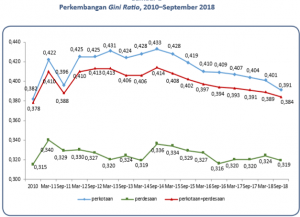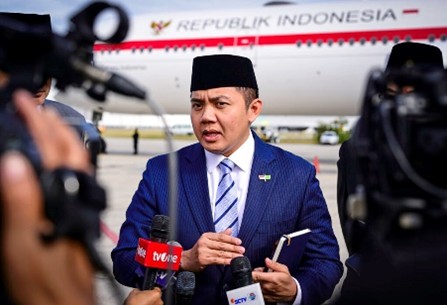BPS: Indonesias Gini Ratio Declines to 0.384
 Spending gap among Indonesians recorded in Gini Ratio declined in September 2018 to 0.384, according to the data from the Central Statistics Agency (BPS).
Spending gap among Indonesians recorded in Gini Ratio declined in September 2018 to 0.384, according to the data from the Central Statistics Agency (BPS).
The figure declined by 0.005 point compared to Gini Ratio in March 2018 which stood at 0.389. In addition, comparing to Gini Ratio in September 2017 which stood at 0.391, the current ratio shows a decrease of 0.007 point, the Head of BPS Suhariyanto said in a press conference at the BPS Office, Jakarta, on Tuesday (15/1).
According to Suriharyanto, Indonesias Gini Ratio from 2010 to September 2014 fluctuated, but the Gini ratio has continued to decline from March 2015 to September 2018. This state indicates that during March 2015 September 2018 spending equality in Indonesia has improved, Suhariyanto added.
Based on the area of residence, Gini Ratio in urban areas in September 2018 stood at 0.391, or decreased by 0.010 point compared to the figure in March 2018 was 0.401, and decreased by 0.013 point compared to the same period in 2017.
In rural areas, Gini Ratio in September 2018 stood at 0.319, or decreased by 0.005 point compared to the figure in March 2018 which was 0.324, and decreased by 0.001 point compared to the same period in 2017 which was 0.320.
The BPS Head went on to say that besides Gini Ratio, another indicator of inequality is percentage of spending of the bottom 40 percent of the population or known as the World Bank standard. According to the standard, inequality is divided into three categories namely severe inequality in which percentage of spending of the bottom 40 percent is less than 12 percent; medium inequality in which the percentage is between 12 and 17 percent; and light inequality in which the percentage is above 17 percent.
Suhariyanto added that in September 2018, percentage of spending of the bottom 40 percent in Indonesia stood at 17.47 percent which means it is still classified as light inequality.
The figure increased compared to that in March 2018 which stood at 17.29 percent and September 2017 which was 17.22 percent. It indicates that equality has improved from September 2017 to September 2018, Suhariyanto explained.
The BPS Head added that in September 2018, percentage of spending of the bottom 40 percent in urban areas was 16.79 percent, while the percentage in rural areas stood at 20.43 percent. Thus, based on the World Bank standard, urban areas is classified as medium inequality, while rural areas is classified as light inequality, he said. (BPS PR Divison/ES)
Translated by : Rany Anjany Subachrum
Edited by : M. Ersan Pamungkas








